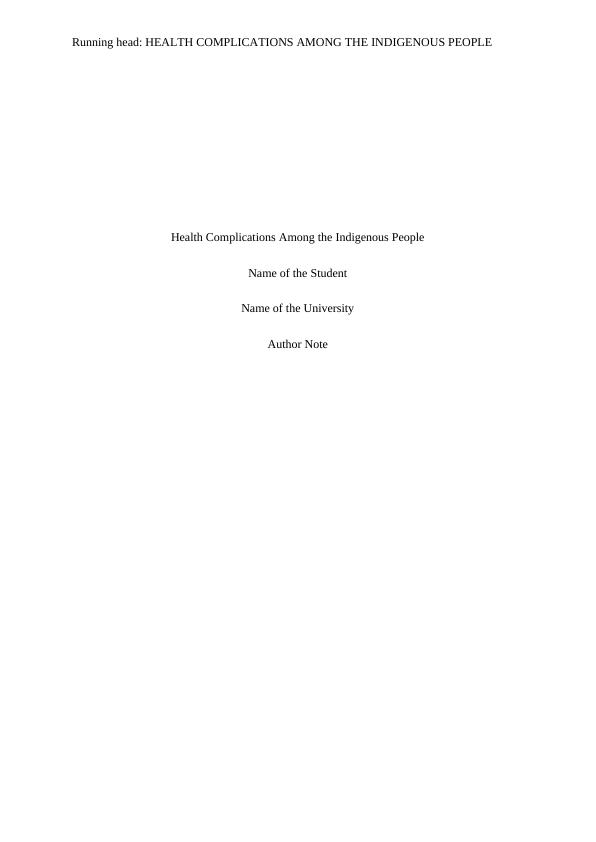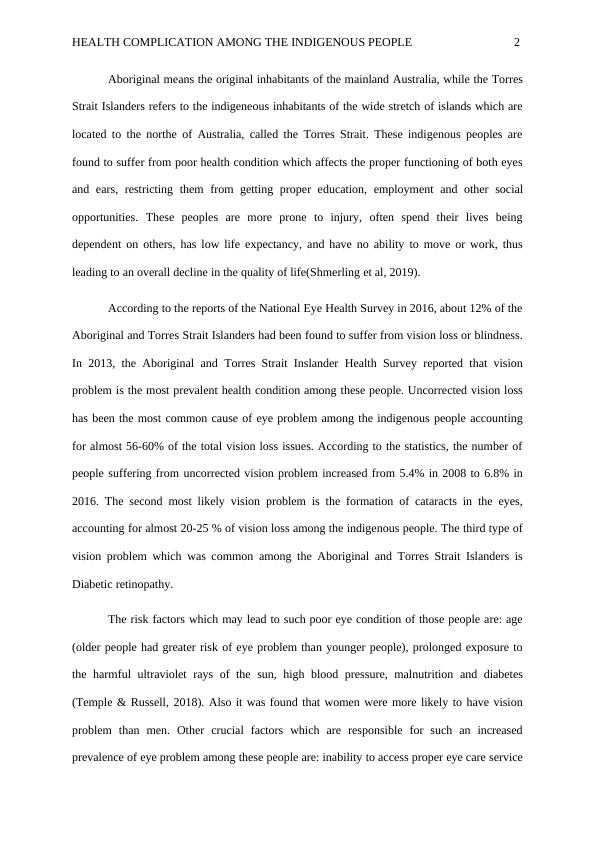Health Complication Among the Indigenous People.
Added on 2022-08-29
7 Pages1851 Words16 Views
Running head: HEALTH COMPLICATIONS AMONG THE INDIGENOUS PEOPLE
Health Complications Among the Indigenous People
Name of the Student
Name of the University
Author Note
Health Complications Among the Indigenous People
Name of the Student
Name of the University
Author Note

HEALTH COMPLICATION AMONG THE INDIGENOUS PEOPLE 2
Aboriginal means the original inhabitants of the mainland Australia, while the Torres
Strait Islanders refers to the indigeneous inhabitants of the wide stretch of islands which are
located to the northe of Australia, called the Torres Strait. These indigenous peoples are
found to suffer from poor health condition which affects the proper functioning of both eyes
and ears, restricting them from getting proper education, employment and other social
opportunities. These peoples are more prone to injury, often spend their lives being
dependent on others, has low life expectancy, and have no ability to move or work, thus
leading to an overall decline in the quality of life(Shmerling et al, 2019).
According to the reports of the National Eye Health Survey in 2016, about 12% of the
Aboriginal and Torres Strait Islanders had been found to suffer from vision loss or blindness.
In 2013, the Aboriginal and Torres Strait Inslander Health Survey reported that vision
problem is the most prevalent health condition among these people. Uncorrected vision loss
has been the most common cause of eye problem among the indigenous people accounting
for almost 56-60% of the total vision loss issues. According to the statistics, the number of
people suffering from uncorrected vision problem increased from 5.4% in 2008 to 6.8% in
2016. The second most likely vision problem is the formation of cataracts in the eyes,
accounting for almost 20-25 % of vision loss among the indigenous people. The third type of
vision problem which was common among the Aboriginal and Torres Strait Islanders is
Diabetic retinopathy.
The risk factors which may lead to such poor eye condition of those people are: age
(older people had greater risk of eye problem than younger people), prolonged exposure to
the harmful ultraviolet rays of the sun, high blood pressure, malnutrition and diabetes
(Temple & Russell, 2018). Also it was found that women were more likely to have vision
problem than men. Other crucial factors which are responsible for such an increased
prevalence of eye problem among these people are: inability to access proper eye care service
Aboriginal means the original inhabitants of the mainland Australia, while the Torres
Strait Islanders refers to the indigeneous inhabitants of the wide stretch of islands which are
located to the northe of Australia, called the Torres Strait. These indigenous peoples are
found to suffer from poor health condition which affects the proper functioning of both eyes
and ears, restricting them from getting proper education, employment and other social
opportunities. These peoples are more prone to injury, often spend their lives being
dependent on others, has low life expectancy, and have no ability to move or work, thus
leading to an overall decline in the quality of life(Shmerling et al, 2019).
According to the reports of the National Eye Health Survey in 2016, about 12% of the
Aboriginal and Torres Strait Islanders had been found to suffer from vision loss or blindness.
In 2013, the Aboriginal and Torres Strait Inslander Health Survey reported that vision
problem is the most prevalent health condition among these people. Uncorrected vision loss
has been the most common cause of eye problem among the indigenous people accounting
for almost 56-60% of the total vision loss issues. According to the statistics, the number of
people suffering from uncorrected vision problem increased from 5.4% in 2008 to 6.8% in
2016. The second most likely vision problem is the formation of cataracts in the eyes,
accounting for almost 20-25 % of vision loss among the indigenous people. The third type of
vision problem which was common among the Aboriginal and Torres Strait Islanders is
Diabetic retinopathy.
The risk factors which may lead to such poor eye condition of those people are: age
(older people had greater risk of eye problem than younger people), prolonged exposure to
the harmful ultraviolet rays of the sun, high blood pressure, malnutrition and diabetes
(Temple & Russell, 2018). Also it was found that women were more likely to have vision
problem than men. Other crucial factors which are responsible for such an increased
prevalence of eye problem among these people are: inability to access proper eye care service

HEALTH COMPLICATION AMONG THE INDIGENOUS PEOPLE 2
in the remote areas, being unable to afford the treatment cost, living a sub standard quality of
life, lack of proper education on satination and hyegine.
Apart from eye problems, the other major health issue for the Aboriginal and Torres
Strait Islanders are ear infection resulting in hearing loss. The children and the adolescent
group of people were more likely to suffer from ear infection. The most common ear disease
among those people are Otitis Media, which causes inflammation in the middle ear owing to
infection caused by bacteria or viral pathogens(Newell et al, 2019). Studies show that the
indigenous people are more prone to ear infection than the non-indigenous people. Likewise,
the rate of burden of otitis media was found to be around 9 times high among the indigenous
people than the non-indigenous people. Hearing loss leads to loss in cognitive functioning
and interferes with auditory processing skills. It was suggested that the children who were not
breastfed properly or suffered from malnutrition, had an increased risk of otitis
media(Mealings et al, 2020).
However, in recent times, the vision gap among these people has been reduced to a
great extent. The State, Federal and Territorial government have implemented various health
programs to address the issue of vision loss among those people, such as eye care programs,
provision of primary health care service along with fundings for ophthalmology. The
Government also implemented policies for providing effective treatment to those indigenous
people at low and affordable cost(Arthur, 2018). In 2013, the World Health Assembly
launched a program called “Universal Eye Health” with an intention to reduce the prevalence
of vision problem among the Aboriginal ans Torres Strait Islander people. The Primary
Health Care Activity is an integral constituent of the Indigenous Australia’s Health
Programme (IAHP) and is responsible for ensuring that these indigenous people have equal
access to affordable and culturally safe healthcare services(Burnett et al, 2016). The
Aborigical Community Controlled Health Service provides those people with effective,
in the remote areas, being unable to afford the treatment cost, living a sub standard quality of
life, lack of proper education on satination and hyegine.
Apart from eye problems, the other major health issue for the Aboriginal and Torres
Strait Islanders are ear infection resulting in hearing loss. The children and the adolescent
group of people were more likely to suffer from ear infection. The most common ear disease
among those people are Otitis Media, which causes inflammation in the middle ear owing to
infection caused by bacteria or viral pathogens(Newell et al, 2019). Studies show that the
indigenous people are more prone to ear infection than the non-indigenous people. Likewise,
the rate of burden of otitis media was found to be around 9 times high among the indigenous
people than the non-indigenous people. Hearing loss leads to loss in cognitive functioning
and interferes with auditory processing skills. It was suggested that the children who were not
breastfed properly or suffered from malnutrition, had an increased risk of otitis
media(Mealings et al, 2020).
However, in recent times, the vision gap among these people has been reduced to a
great extent. The State, Federal and Territorial government have implemented various health
programs to address the issue of vision loss among those people, such as eye care programs,
provision of primary health care service along with fundings for ophthalmology. The
Government also implemented policies for providing effective treatment to those indigenous
people at low and affordable cost(Arthur, 2018). In 2013, the World Health Assembly
launched a program called “Universal Eye Health” with an intention to reduce the prevalence
of vision problem among the Aboriginal ans Torres Strait Islander people. The Primary
Health Care Activity is an integral constituent of the Indigenous Australia’s Health
Programme (IAHP) and is responsible for ensuring that these indigenous people have equal
access to affordable and culturally safe healthcare services(Burnett et al, 2016). The
Aborigical Community Controlled Health Service provides those people with effective,

End of preview
Want to access all the pages? Upload your documents or become a member.
Related Documents
Health Disparity in Hearing, Sight and Other Senses among Aboriginal and Torres Strait Islander Population of Australialg...
|11
|2331
|233
Introduction Australia’s Governments has been facing thelg...
|7
|1972
|1
Hearing and special senses among Aboriginalslg...
|10
|2259
|167
Ear and Hearing Problems among Aboriginal and Torres Strait Islander Australianslg...
|10
|2477
|207
Integrating Equity into Health Strategies, Programmes and Activities Assignment 2022lg...
|16
|4510
|9
Contemporary Indigenous Health and Wellbeinglg...
|10
|2616
|445
